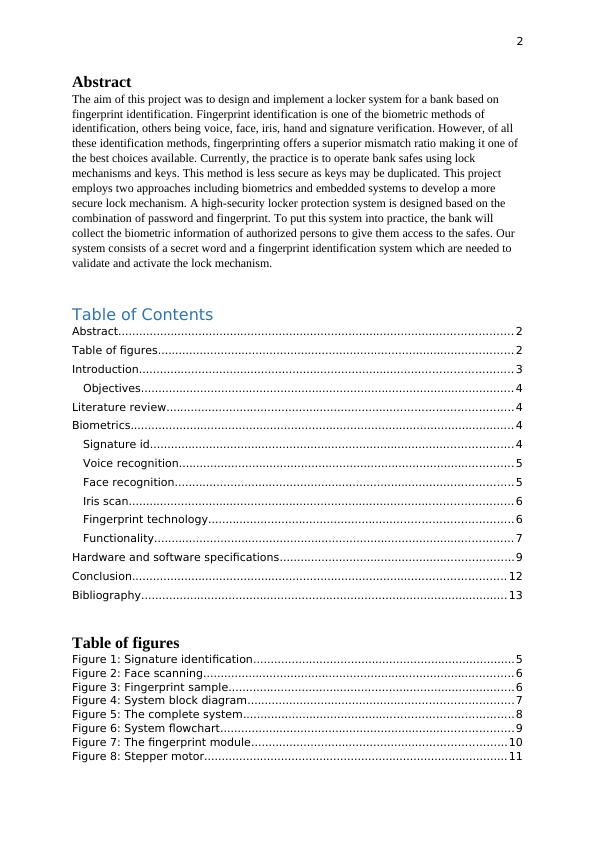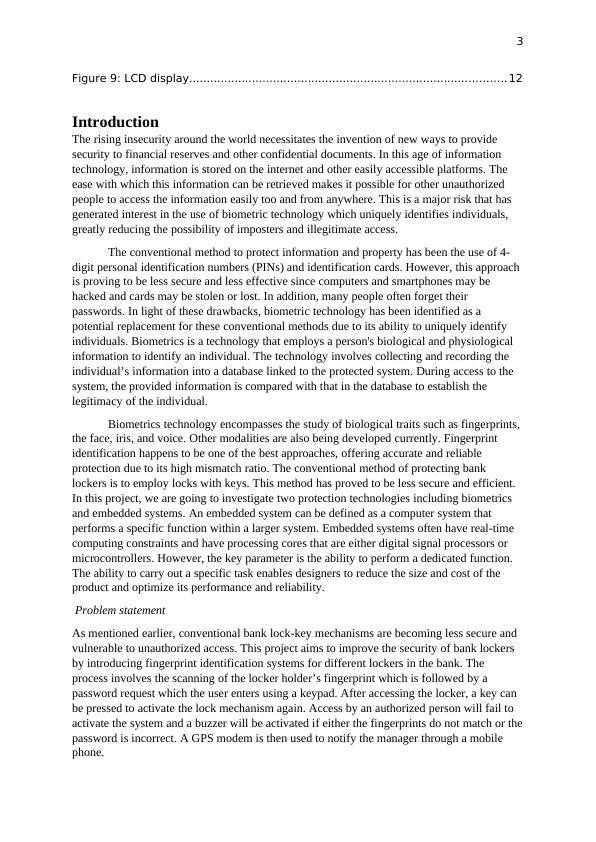Fingerprint Based Bank Locker System
Aim of this project is to control the unmanned rail gate automatically utilizing embedded platform
13 Pages3112 Words26 Views
Added on 2022-08-27
Fingerprint Based Bank Locker System
Aim of this project is to control the unmanned rail gate automatically utilizing embedded platform
Added on 2022-08-27
ShareRelated Documents
1
Fingerprint Based Bank Locker
Student’s Name
Institutional Affiliation
Date
Fingerprint Based Bank Locker
Student’s Name
Institutional Affiliation
Date

2
Abstract
The aim of this project was to design and implement a locker system for a bank based on
fingerprint identification. Fingerprint identification is one of the biometric methods of
identification, others being voice, face, iris, hand and signature verification. However, of all
these identification methods, fingerprinting offers a superior mismatch ratio making it one of
the best choices available. Currently, the practice is to operate bank safes using lock
mechanisms and keys. This method is less secure as keys may be duplicated. This project
employs two approaches including biometrics and embedded systems to develop a more
secure lock mechanism. A high-security locker protection system is designed based on the
combination of password and fingerprint. To put this system into practice, the bank will
collect the biometric information of authorized persons to give them access to the safes. Our
system consists of a secret word and a fingerprint identification system which are needed to
validate and activate the lock mechanism.
Table of Contents
Abstract................................................................................................................. 2
Table of figures...................................................................................................... 2
Introduction........................................................................................................... 3
Objectives........................................................................................................... 4
Literature review................................................................................................... 4
Biometrics.............................................................................................................. 4
Signature id........................................................................................................ 4
Voice recognition................................................................................................ 5
Face recognition................................................................................................. 5
Iris scan.............................................................................................................. 6
Fingerprint technology....................................................................................... 6
Functionality....................................................................................................... 7
Hardware and software specifications...................................................................9
Conclusion........................................................................................................... 12
Bibliography......................................................................................................... 13
Table of figures
Figure 1: Signature identification...........................................................................5
Figure 2: Face scanning......................................................................................... 6
Figure 3: Fingerprint sample..................................................................................6
Figure 4: System block diagram............................................................................ 7
Figure 5: The complete system.............................................................................8
Figure 6: System flowchart.................................................................................... 9
Figure 7: The fingerprint module.........................................................................10
Figure 8: Stepper motor....................................................................................... 11
Abstract
The aim of this project was to design and implement a locker system for a bank based on
fingerprint identification. Fingerprint identification is one of the biometric methods of
identification, others being voice, face, iris, hand and signature verification. However, of all
these identification methods, fingerprinting offers a superior mismatch ratio making it one of
the best choices available. Currently, the practice is to operate bank safes using lock
mechanisms and keys. This method is less secure as keys may be duplicated. This project
employs two approaches including biometrics and embedded systems to develop a more
secure lock mechanism. A high-security locker protection system is designed based on the
combination of password and fingerprint. To put this system into practice, the bank will
collect the biometric information of authorized persons to give them access to the safes. Our
system consists of a secret word and a fingerprint identification system which are needed to
validate and activate the lock mechanism.
Table of Contents
Abstract................................................................................................................. 2
Table of figures...................................................................................................... 2
Introduction........................................................................................................... 3
Objectives........................................................................................................... 4
Literature review................................................................................................... 4
Biometrics.............................................................................................................. 4
Signature id........................................................................................................ 4
Voice recognition................................................................................................ 5
Face recognition................................................................................................. 5
Iris scan.............................................................................................................. 6
Fingerprint technology....................................................................................... 6
Functionality....................................................................................................... 7
Hardware and software specifications...................................................................9
Conclusion........................................................................................................... 12
Bibliography......................................................................................................... 13
Table of figures
Figure 1: Signature identification...........................................................................5
Figure 2: Face scanning......................................................................................... 6
Figure 3: Fingerprint sample..................................................................................6
Figure 4: System block diagram............................................................................ 7
Figure 5: The complete system.............................................................................8
Figure 6: System flowchart.................................................................................... 9
Figure 7: The fingerprint module.........................................................................10
Figure 8: Stepper motor....................................................................................... 11

3
Figure 9: LCD display........................................................................................... 12
Introduction
The rising insecurity around the world necessitates the invention of new ways to provide
security to financial reserves and other confidential documents. In this age of information
technology, information is stored on the internet and other easily accessible platforms. The
ease with which this information can be retrieved makes it possible for other unauthorized
people to access the information easily too and from anywhere. This is a major risk that has
generated interest in the use of biometric technology which uniquely identifies individuals,
greatly reducing the possibility of imposters and illegitimate access.
The conventional method to protect information and property has been the use of 4-
digit personal identification numbers (PINs) and identification cards. However, this approach
is proving to be less secure and less effective since computers and smartphones may be
hacked and cards may be stolen or lost. In addition, many people often forget their
passwords. In light of these drawbacks, biometric technology has been identified as a
potential replacement for these conventional methods due to its ability to uniquely identify
individuals. Biometrics is a technology that employs a person's biological and physiological
information to identify an individual. The technology involves collecting and recording the
individual’s information into a database linked to the protected system. During access to the
system, the provided information is compared with that in the database to establish the
legitimacy of the individual.
Biometrics technology encompasses the study of biological traits such as fingerprints,
the face, iris, and voice. Other modalities are also being developed currently. Fingerprint
identification happens to be one of the best approaches, offering accurate and reliable
protection due to its high mismatch ratio. The conventional method of protecting bank
lockers is to employ locks with keys. This method has proved to be less secure and efficient.
In this project, we are going to investigate two protection technologies including biometrics
and embedded systems. An embedded system can be defined as a computer system that
performs a specific function within a larger system. Embedded systems often have real-time
computing constraints and have processing cores that are either digital signal processors or
microcontrollers. However, the key parameter is the ability to perform a dedicated function.
The ability to carry out a specific task enables designers to reduce the size and cost of the
product and optimize its performance and reliability.
Problem statement
As mentioned earlier, conventional bank lock-key mechanisms are becoming less secure and
vulnerable to unauthorized access. This project aims to improve the security of bank lockers
by introducing fingerprint identification systems for different lockers in the bank. The
process involves the scanning of the locker holder’s fingerprint which is followed by a
password request which the user enters using a keypad. After accessing the locker, a key can
be pressed to activate the lock mechanism again. Access by an authorized person will fail to
activate the system and a buzzer will be activated if either the fingerprints do not match or the
password is incorrect. A GPS modem is then used to notify the manager through a mobile
phone.
Figure 9: LCD display........................................................................................... 12
Introduction
The rising insecurity around the world necessitates the invention of new ways to provide
security to financial reserves and other confidential documents. In this age of information
technology, information is stored on the internet and other easily accessible platforms. The
ease with which this information can be retrieved makes it possible for other unauthorized
people to access the information easily too and from anywhere. This is a major risk that has
generated interest in the use of biometric technology which uniquely identifies individuals,
greatly reducing the possibility of imposters and illegitimate access.
The conventional method to protect information and property has been the use of 4-
digit personal identification numbers (PINs) and identification cards. However, this approach
is proving to be less secure and less effective since computers and smartphones may be
hacked and cards may be stolen or lost. In addition, many people often forget their
passwords. In light of these drawbacks, biometric technology has been identified as a
potential replacement for these conventional methods due to its ability to uniquely identify
individuals. Biometrics is a technology that employs a person's biological and physiological
information to identify an individual. The technology involves collecting and recording the
individual’s information into a database linked to the protected system. During access to the
system, the provided information is compared with that in the database to establish the
legitimacy of the individual.
Biometrics technology encompasses the study of biological traits such as fingerprints,
the face, iris, and voice. Other modalities are also being developed currently. Fingerprint
identification happens to be one of the best approaches, offering accurate and reliable
protection due to its high mismatch ratio. The conventional method of protecting bank
lockers is to employ locks with keys. This method has proved to be less secure and efficient.
In this project, we are going to investigate two protection technologies including biometrics
and embedded systems. An embedded system can be defined as a computer system that
performs a specific function within a larger system. Embedded systems often have real-time
computing constraints and have processing cores that are either digital signal processors or
microcontrollers. However, the key parameter is the ability to perform a dedicated function.
The ability to carry out a specific task enables designers to reduce the size and cost of the
product and optimize its performance and reliability.
Problem statement
As mentioned earlier, conventional bank lock-key mechanisms are becoming less secure and
vulnerable to unauthorized access. This project aims to improve the security of bank lockers
by introducing fingerprint identification systems for different lockers in the bank. The
process involves the scanning of the locker holder’s fingerprint which is followed by a
password request which the user enters using a keypad. After accessing the locker, a key can
be pressed to activate the lock mechanism again. Access by an authorized person will fail to
activate the system and a buzzer will be activated if either the fingerprints do not match or the
password is incorrect. A GPS modem is then used to notify the manager through a mobile
phone.

4
Objectives
The objective is to employ a single fingerprint module to scan several authorized personnel to
open the bank lockers. The data for the individuals will be stored in the RAM of the
LPC2148 microcontroller chip. The LPC2148 controls the scanning procedure and is
interfaced with the fingerprint scanner. The completion of the scanning procedure will direct
the user to enter the password as the final security requirement. The system will incorporate
options for registering new users and eliminating users who are no longer allowed to access
the lockers.
Literature review
Identification number
The identification number (ID) is widely used for the unique identification of individuals
globally. It can be a government-issued ID, passport, voter registration card, and driving
license. It is the same approach used in the opening of a bank account or a locker. After
verification, the customer is allowed to set a unique PIN or one is given by the
administration. Normally, the user is given three chances to provide the correct key to access
the locker. After the three chances, any entry triggers an alarm to the bank administration.
Digital code lock
This is a type of lock mechanism that is installed at every locker door. It is based on a
microcontroller that provides access if the right passkey is provided. The digital code is
usually a 6 digit numeric without any characters. The microcontroller interface with the lock
has a memory that stores the password. It is not expensive, hence can be used on all lockers.
The system authenticates the user and acts as an intermediary to the next level of
authentication. This is provided by the bank to the holder during registration and may be
changed only by authorized bank administrators. The system gives the holder three trials. If
they fail to provide the right credentials, an alarm is triggered. The lock has an LCD screen
and a keypad with 12 keys from 0 to 9, *, and #. Asterisk is used to delete a single digit. # is
used to submit 6 digit passwords. The LCD is the communication interface between the user
and the machine, displaying the typed digits.
Biometrics
Biometrics is a term derived from the Greek words "bio" meaning life and "metric" meaning
to measure. Therefore, biometrics may be defined as the recognition and identification of an
individual based on their biological or physiological characteristics.
Signature id
This involves the analysis of how an individual signs their name. This process is known as
dynamic signature verification (DSV). The process involves the analysis of properties such as
the number of times the signing instrument is lifted, the angle the device is held, the time
taken to complete the signature, the changes in the speed of writing the various parts of the
Objectives
The objective is to employ a single fingerprint module to scan several authorized personnel to
open the bank lockers. The data for the individuals will be stored in the RAM of the
LPC2148 microcontroller chip. The LPC2148 controls the scanning procedure and is
interfaced with the fingerprint scanner. The completion of the scanning procedure will direct
the user to enter the password as the final security requirement. The system will incorporate
options for registering new users and eliminating users who are no longer allowed to access
the lockers.
Literature review
Identification number
The identification number (ID) is widely used for the unique identification of individuals
globally. It can be a government-issued ID, passport, voter registration card, and driving
license. It is the same approach used in the opening of a bank account or a locker. After
verification, the customer is allowed to set a unique PIN or one is given by the
administration. Normally, the user is given three chances to provide the correct key to access
the locker. After the three chances, any entry triggers an alarm to the bank administration.
Digital code lock
This is a type of lock mechanism that is installed at every locker door. It is based on a
microcontroller that provides access if the right passkey is provided. The digital code is
usually a 6 digit numeric without any characters. The microcontroller interface with the lock
has a memory that stores the password. It is not expensive, hence can be used on all lockers.
The system authenticates the user and acts as an intermediary to the next level of
authentication. This is provided by the bank to the holder during registration and may be
changed only by authorized bank administrators. The system gives the holder three trials. If
they fail to provide the right credentials, an alarm is triggered. The lock has an LCD screen
and a keypad with 12 keys from 0 to 9, *, and #. Asterisk is used to delete a single digit. # is
used to submit 6 digit passwords. The LCD is the communication interface between the user
and the machine, displaying the typed digits.
Biometrics
Biometrics is a term derived from the Greek words "bio" meaning life and "metric" meaning
to measure. Therefore, biometrics may be defined as the recognition and identification of an
individual based on their biological or physiological characteristics.
Signature id
This involves the analysis of how an individual signs their name. This process is known as
dynamic signature verification (DSV). The process involves the analysis of properties such as
the number of times the signing instrument is lifted, the angle the device is held, the time
taken to complete the signature, the changes in the speed of writing the various parts of the

End of preview
Want to access all the pages? Upload your documents or become a member.
Related Documents
ITC595 Information Security - Doclg...
|4
|4949
|221
Mitigating Concerns with Biometrics for Identificationlg...
|3
|711
|83
Biometric Systems, Privacy Enhancing Technologies and Wireless Sensor Networkslg...
|11
|2471
|380
The Evolution of Biometrics | Capitol Technologylg...
|5
|707
|22
Biometric Authentication: System Security & Privacylg...
|6
|3012
|32
The Concept Of Biometric Authenticationlg...
|35
|10751
|12
